Learning the mechanical layout of the Scriptures will help you see the relationships between words, phrases and clauses in sentences. Therefore you will see how these words, phrases or clauses fit into the overall meaning of the Scriptures you are studying.
To put it another way, the mechanical layout of the Scriptures is simply outlining the thought patterns in a diagrammatical way. This will help you understand with greater clarity the message of the Bible.
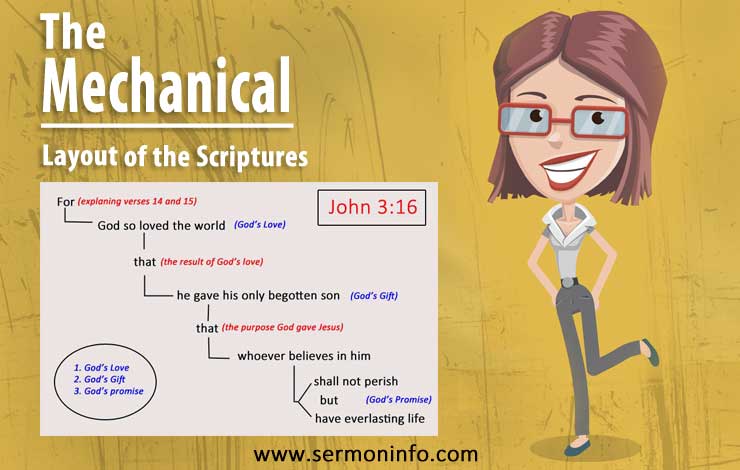
The Mechanical Layout of the Scriptures
The basic unit of thought in a grammatical structure is the sentence. The sentence is made up of words, phrases and clauses. To understand the meaning of a sentence, you need to analyze the basic units of thought. The mechanical layout is one tool that helps you do this.
The mechanical layout of the Scriptures will involve three stages. First, you will need to analyze the grammatical structure of the verse or verses of Scriptures that you are studying. Second, you will need to sketch a mechanical layout of the structure of the verse or verses that you are studying. Third, you will need to outline the flow of thought from the verse or verses that you are studying.
1. ANALYZE THE GRAMMATICAL STRUCTURE
Sketching the mechanical layout of the Scriptures will require at least a rudimentary knowledge of grammar (nouns, pronouns, verbs, adjectives, adverbs, conjunctions, prepositions, etc. etc.) and how they function in sentences (subject, verb, object, complement or modifier).
You will need to recognize the various parts of speech and the role they play in the structure of the sentence. In addition, you will need to understand the relationships of various phrases and clauses in the structure of a sentence and their contribution to the meaning of the sentence.
A. There are the eight parts of speech
- nouns – name a person, place, thing or idea
- pronouns – take the place of a noun
- verbs – show action or state-of-being
- adjectives – modify nouns
- adverbs – modify verbs, adjectives and other adverbs
- prepositions – show position and how things go together
- conjunctions – are joining words
- interjections – expresse strong or sudden feeling
There are two main components and three optional parts of the sentence. These components and parts show how the parts of speech function in a sentence as words, phrases and clauses to convey a message.
B. There two main components of the sentence
- subject – what the sentences is about and who performs the action
- predicate – what the subject does or is
C. There are three optional parts of the sentence
- object – the entity that is acted upon by the subject
- complement – completes a given expression
- modifier – provides additional information and function as an adverb or adjective
You can see this in action by noting the following three examples from the Scriptures.
D. There are three examples from the Scriptures
First Example:
John 3:16, “For God so loved the world that he gave his only begotten son that whoever believes in him shall not perish but have everlasting life.”
You can break this verse of Scripture into three parts: First, God so loved the word. Second, he gave his only begotten son and third, whoever believes in him shall not perish but have everlasting life.
When you sketch the mechanical layout of this verse, you need to trace the flow of these three parts and how they relate to each other.
Second Example:
Hebrews 12:1-2a, “Therefore we also, since we are surrounded by so great a cloud of witnesses, let us lay aside every weight, and the sin which so easily ensnares us, and let us run with endurance the race that is set before us, looking unto Jesus, the author and finisher of our faith.”
You can break these verses of Scripture into four parts: First, let us run the race set before us with endurance. Second, we are surrounded by so great a cloud of witnesses. Third, let us lay aside every weight and the sin which so easily ensnares us and fourth, let us look unto Jesus the author and finisher of our faith.
Again, when you sketch the mechanical layout of these verses, you need to trace the flow of these four parts and how they relate to each other.
Third Example:
2 Timothy 3:16-17, “All Scripture is given by inspiration of God, and is profitable for doctrine, for reproof, for correction, for instruction in righteousness, that the man of God may be complete, thoroughly equipped for every good work.”
You can break these verses of Scripture into three parts. First, all Scripture is given by inspiration. Second, all Scripture is profitable for doctrine, for reproof, for correction, for instruction in righteousness and third, that the man of God may be complete, thoroughly equipped for every good work.
Again when you sketch the mechanical layout of these verses of Scripture, you need to trace the flow of these three parts and how they relate to each other.
2. SKETCH THE MECHANICAL LAYOUT
The mechanical layout of the Scriptures forces you to trace the flow of thought throughout the verse or verses of Scripture which you are studying. Also it forces you to analyze the relationships between those thoughts as they unfold in the verse or verses of Scripture.
A. The Mechanical Layout of John 3:16
When you trace the pattern of thought in John 3:16, it becomes clear that the verse is divided into three clauses. The first clause describes the greatness of God’s love. The second clause gives the result of the greatness of God’s love and that is his gift of his son. The third clause tells you the purpose of his great gift of his son which is his great promise to all who believe in Jesus.
When you sketch the mechanical layout of John 3:16, you soon see the main clause and the subordinate clauses and how they relate to each other. If you are preaching this verse, the mechanical layout will give you a sermon outline that you will be able to follow (more on this below).
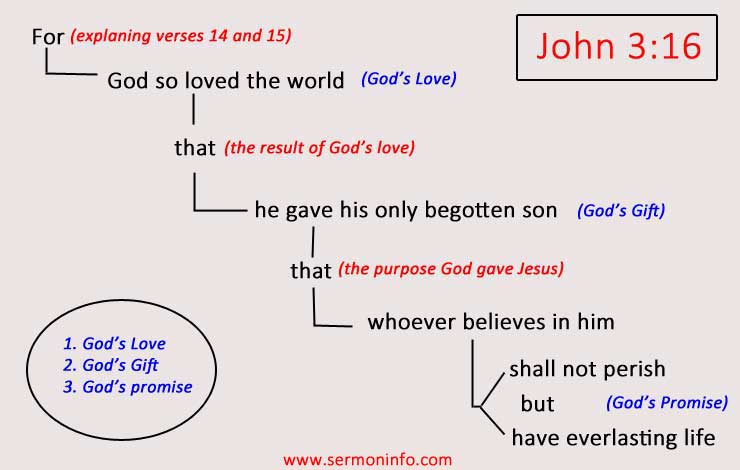
B. The Mechanical Layout of Hebrews 12:1-2a
When you determine the pattern of thought in Hebrews 12:1-2a, you will discover that the main verbal proportion in these verses is “let us run the race set before us.” The subordinate verbals are with endurance, with the inspiration of past witnesses, laying aside every weight and every sin and looking unto Jesus the author and finisher of our faith.
By sketching a mechanical layout of Hebrews 12:1-2a, it gives you a great overview of its meaning. Moreover, you soon see a natural sermon outline so that you can preach these verse in a meaningful way (more on this below).
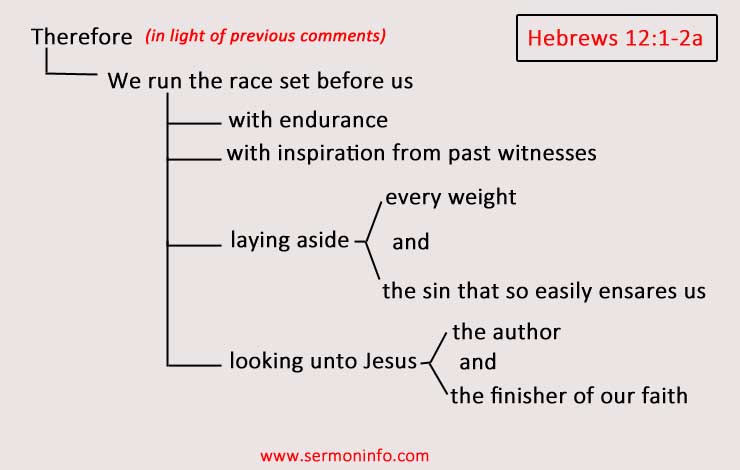
C. The Mechanical Layout of 2 Timothy 3:16-17
When you discover the pattern of thought in 2 Timothy 3:16-17, you will notice that there are three main ideas. The first idea highlights the inspiration of God’s word. The second idea states the profitability of God’s word. The third idea explains the dependability of God’s words.
When you sketch the mechanical layout of 2 Timothy 3:16-17, you soon discover the overall view of these two verses. Again, you will see a natural and progress outline of the passage of Scripture (more on this below).
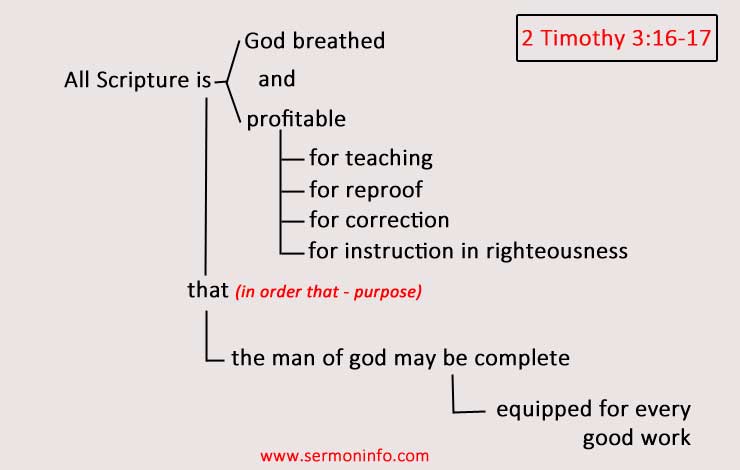
3. OUTLINE THE FLOW
Once you have sketched the mechanical layout of the Scriptures, you simply need to outline the flow of thought into a preaching outline. The benefits of sketching a mechanical layout of the Scriptures are enormous for your preaching ministry. Using this method, you will preach biblical sermons.
A. Outline of John 3:16
I find once you have done the hard work sketching the mechanical layout, it is quite easy to create a preaching outline. See below for a brief sketch of a preaching outline of John 3:16!
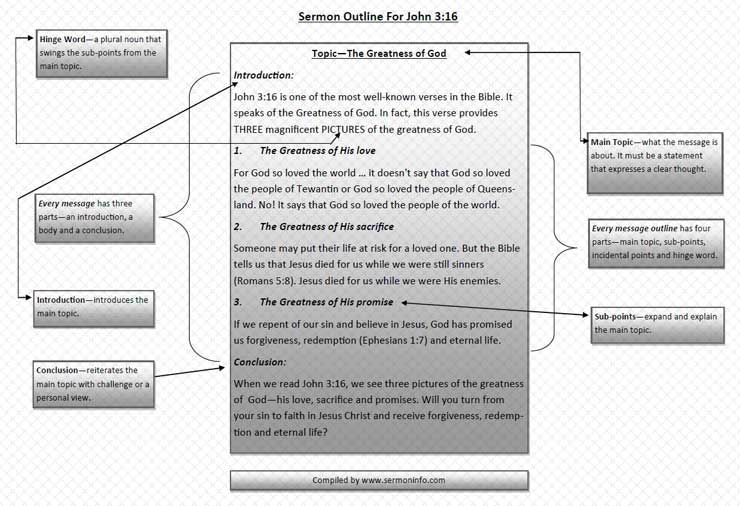
B. Outline of Hebrews 12:1-2
The mechanical layout of Hebrews 12:1-2a helps you to organize flow of thoughts into a great preaching outline. See below for a brief sketch of the preaching outline of Hebrews 12:1-2a!
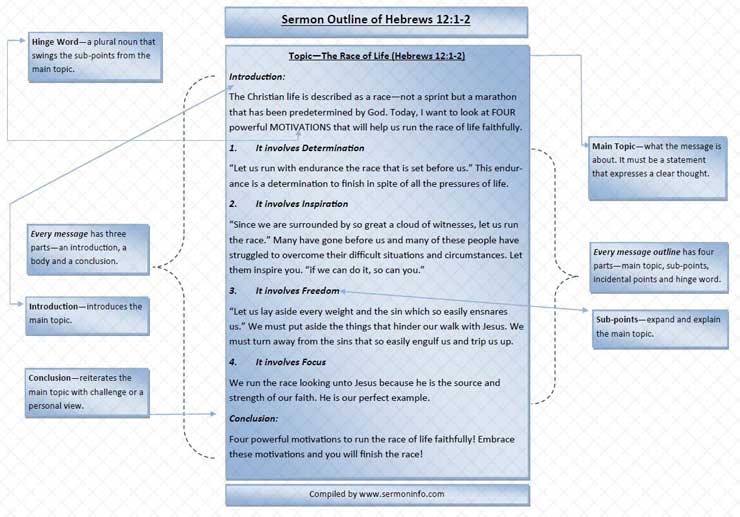
C. Outline of 2 Timothy 3:16-17
The mechanical layout of the Scriptures definitely highlighted the main flow of 2 Timothy 3:16-17. Below is a complete preaching outline of 2 Timothy 3:16-17!
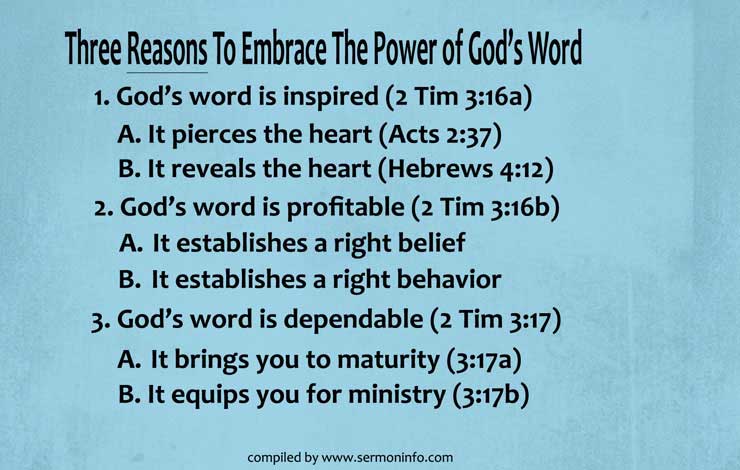
You can check out how to write expository sermon outlines by clicking on this link – Expository Sermon Outlines